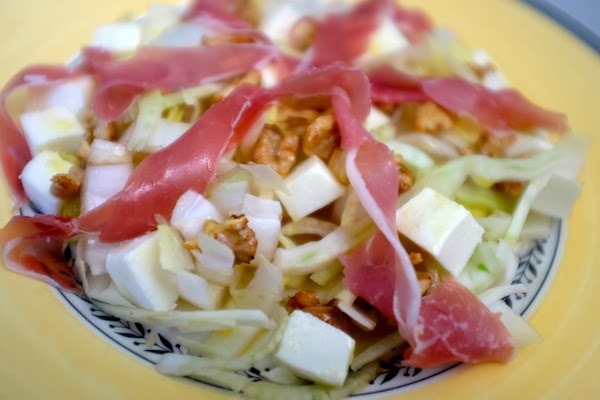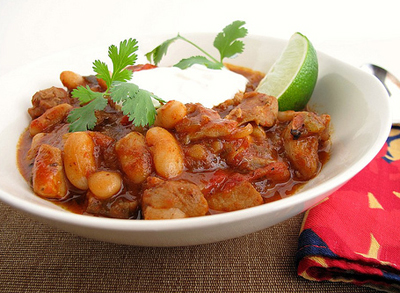 Seriously folks what is with all the bad weather in the U.S.? When I'm tooling around on Facebook I feel like I've been living everyone's bad weather, including my own. So much snow everywhere. Let's hope Spring comes a little early this year. All these gloomy days means the slow cooker has been earning its keep. This Pulled Pork Chile Verde has been something I've been working on. But today it was perfect and that's why I'm sharing it with you.
Seriously folks what is with all the bad weather in the U.S.? When I'm tooling around on Facebook I feel like I've been living everyone's bad weather, including my own. So much snow everywhere. Let's hope Spring comes a little early this year. All these gloomy days means the slow cooker has been earning its keep. This Pulled Pork Chile Verde has been something I've been working on. But today it was perfect and that's why I'm sharing it with you.
My goals for this recipe were straightforward. I wanted a dish that makes enough food for several meals, reheats well, lower in calories and a version even picky eater kids would eat and love. All were accomplished!
In regards to meal times, my older son is easier to please than my younger one. Let's just say I have a real critic when it comes to what he wants to or will eat. But he loved this. I purposefully made it mild enough so the kids would enjoy it. You can do the same and add hot sauce to get the heat you prefer or use a spicier sauce to begin with.
Winter
Winter
Our Favorite Pomegranate Recipes
 A Pink Princess
A Pink Princess
Pomegranate Martini
CosPompolitan
Pomegranate, Gouda and Pear Quesadilla with POM Salsa
Holiday Guacamole
POM and Brie Bruschetta
Chickpea Dip with Toasted Cumin and Pomegranate
Pomegranate Salsa
POM Seared Scallop Salad
Beet and Apple Salad with Honey Dressing and Pomegranate Seeds
Arugula Salad with Persimmons & Pomegranate Seeds
Pomegranate Broiled Salmon with Garlic-Smashed Potatoes
Moroccan Grilled Lambchops with Pomegranate Relish
POM-Glazed Pork Chops with Red Cabbage and Mashed Potatoes
Pan Seared Duck Breast with a POM Thyme Reduction Sauce
Pomegranate and Pistachio Ice Cream | White Chocolate Mousse with Pomegranate Sauce | POM Oatmeal Drops
POM Velvet Cupcakes with POM Cream Cheese Frosting | POM Spicy Baked Pears
Cheesy-Buffalo Roasted Cauliflower-Potato Soup
 Yes, the title is a mouthful, but let me just say, every component plays an integral part in this AMAZING soup.
Yes, the title is a mouthful, but let me just say, every component plays an integral part in this AMAZING soup.
And straight from the mouth of my cauliflower-hating husband..."Hunna (he calls me hunna) when you have guests over, THIS soup has to be on the menu. It has to be "the soup", as in our house soup. One that never-ever goes away." Yep, that's how good it is. This comes from the man that hates cauliflower. He won't let me steam it in the house because it smells so bad. Roasting on the other hand doesn't release those stinky smells and makes the cauliflower taste wonderful.
There is something about this soup that gives it the perfect mouthfeel. The buffalo sauce just adds some awesome highlights and spice.
I highly suggest making a big pot for Super Bowl, it will disappear. And if you happen to serve it with my Easy Artisan Bacon-Cheese Bread, you might hear angels sing. I'm just sayin...
Endive and Fennel Salad with Prosciutto

Endive and fennel just seem to have a natural affinity for one another. Both are crisp, but fennel has a chewier texture and a sweetness, while endive is lighter and juicier and has a slightly bitter edge. You could use them to make a simple side salad but this one has lots of goodies to make it a main dish. Use a Champagne vinaigrette or a Dijon mustard vinaigrette to dress it. Or even just lemon juice and extra virgin olive oil.
Chicken Chili
 I can't think of a better food for the cold days upon us than a big bowl of comforting chili. There is something special about the heat of chile peppers that has a rightful place in this stew. Chili is a great dish for bringing people together and it can feed a crowd very easily. This recipe can be doubled or tripled. It's perfect for when you have group of friends over for game-watching on Super Bowl Sunday. The best part about a recipe like this is that it can be prepared in advance and simply reheated when it's time to serve. No one needs to slave away at the stove and miss watching the game.
I can't think of a better food for the cold days upon us than a big bowl of comforting chili. There is something special about the heat of chile peppers that has a rightful place in this stew. Chili is a great dish for bringing people together and it can feed a crowd very easily. This recipe can be doubled or tripled. It's perfect for when you have group of friends over for game-watching on Super Bowl Sunday. The best part about a recipe like this is that it can be prepared in advance and simply reheated when it's time to serve. No one needs to slave away at the stove and miss watching the game.
Chiles, specifically chile powder or dried chiles, are the key ingredients in making a robust and flavorful chili. But I go further than that and jazz things up with a combination of fresh peppers in varying stages of hotness. I like poblanos for their grassy flavor, red bell for their sweetness, cubanelle for their mild fresh flavor, and jalapeños for the kick. I broil the peppers until their skins blacken and blister. Not only does this step add flavor, it's nicer to eat the chili once the peppers have had their papery skins removed. The hotness of the jalapeños is also tamed by broiling, so the chili doesn't scream hot, but instead it hums.
More Articles ...
Welcome to the new One for the Table ...
Our Home Page will be different each time you arrive.
We're sure you'll find something to pique your interest...


